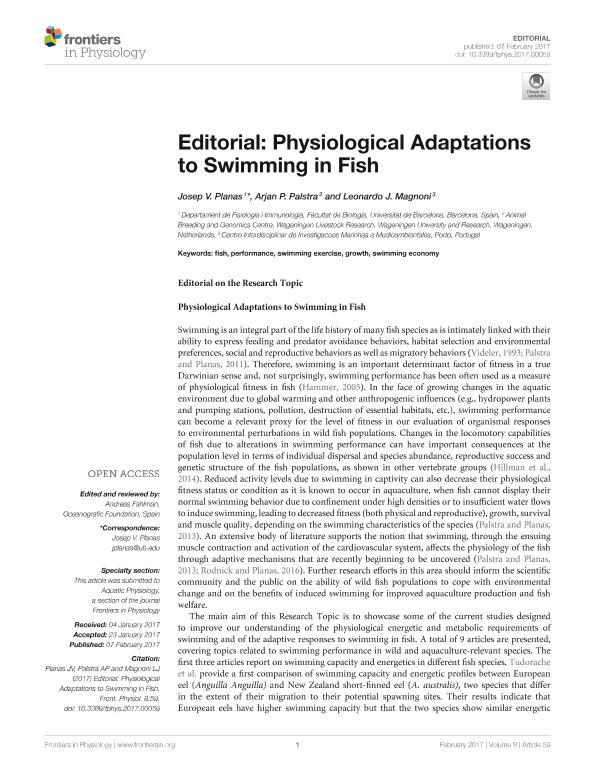Mostrar el registro sencillo del ítem
dc.contributor.author
Planas, Josep V.
dc.contributor.author
Palstra, Arjan P.
dc.contributor.author
Magnoni, Leonardo Julián

dc.date.available
2017-07-28T20:53:40Z
dc.date.issued
2017-02
dc.identifier.citation
Planas, Josep V.; Palstra, Arjan P.; Magnoni, Leonardo Julián; Editorial: Physiological Adaptations to Swimming in Fish; Frontiers; Frontiers in Physiology; 8; 2-2017; 1-2; 59
dc.identifier.issn
2297-7775
dc.identifier.uri
http://hdl.handle.net/11336/21603
dc.description.abstract
Swimming is an integral part of the life history of many fish species as is intimately linked with their ability to express feeding and predator avoidance behaviors, habitat selection and environmental preferences, social and reproductive behaviors as well as migratory behaviors (Videler, 1993; Palstra and Planas, 2011). Therefore, swimming is an important determinant factor of fitness in a true Darwinian sense and, not surprisingly, swimming performance has been often used as a measure of physiological fitness in fish (Hammer, 2005). In the face of growing changes in the aquatic environment due to global warming and other anthropogenic influences (e.g., hydropower plants and pumping stations, pollution, destruction of essential habitats, etc.), swimming performance can become a relevant proxy for the level of fitness in our evaluation of organismal responses to environmental perturbations in wild fish populations. Changes in the locomotory capabilities of fish due to alterations in swimming performance can have important consequences at the population level in terms of individual dispersal and species abundance, reproductive success and genetic structure of the fish populations, as shown in other vertebrate groups (Hillman et al., 2014). Reduced activity levels due to swimming in captivity can also decrease their physiological fitness status or condition as it is known to occur in aquaculture, when fish cannot display their normal swimming behavior due to confinement under high densities or to insufficient water flows to induce swimming, leading to decreased fitness (both physical and reproductive), growth, survival and muscle quality, depending on the swimming characteristics of the species (Palstra and Planas, 2013). An extensive body of literature supports the notion that swimming, through the ensuing muscle contraction and activation of the cardiovascular system, affects the physiology of the fish through adaptive mechanisms that are recently beginning to be uncovered (Palstra and Planas, 2013; Rodnick and Planas, 2016). Further research efforts in this area should inform the scientific community and the public on the ability of wild fish populations to cope with environmental change and on the benefits of induced swimming for improved aquaculture production and fish welfare.
dc.format
application/pdf
dc.language.iso
eng
dc.publisher
Frontiers

dc.rights
info:eu-repo/semantics/openAccess
dc.rights.uri
https://creativecommons.org/licenses/by-nc-sa/2.5/ar/
dc.subject
Fish
dc.subject
Growth
dc.subject
Performance
dc.subject
Swimming Economy
dc.subject
Swimming Exercise
dc.subject.classification
Agricultura

dc.subject.classification
Agricultura, Silvicultura y Pesca

dc.subject.classification
CIENCIAS AGRÍCOLAS

dc.title
Editorial: Physiological Adaptations to Swimming in Fish
dc.type
info:eu-repo/semantics/article
dc.type
info:ar-repo/semantics/artículo
dc.type
info:eu-repo/semantics/publishedVersion
dc.date.updated
2017-07-13T18:17:04Z
dc.journal.volume
8
dc.journal.pagination
1-2; 59
dc.journal.pais
Suiza

dc.description.fil
Fil: Planas, Josep V.. Universidad de Barcelona; España
dc.description.fil
Fil: Palstra, Arjan P.. University Of Agriculture Wageningen; Países Bajos
dc.description.fil
Fil: Magnoni, Leonardo Julián. Centro Interdisciplinar de Investigacoes Marinhas e Medioambientales; Portugal. Consejo Nacional de Investigaciones Científicas y Técnicas; Argentina
dc.journal.title
Frontiers in Physiology
dc.relation.alternativeid
info:eu-repo/semantics/altIdentifier/doi/http://dx.doi.org/10.3389/fphys.2017.00059
dc.relation.alternativeid
info:eu-repo/semantics/altIdentifier/url/http://journal.frontiersin.org/article/10.3389/fphys.2017.00059/full
Archivos asociados
